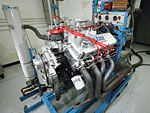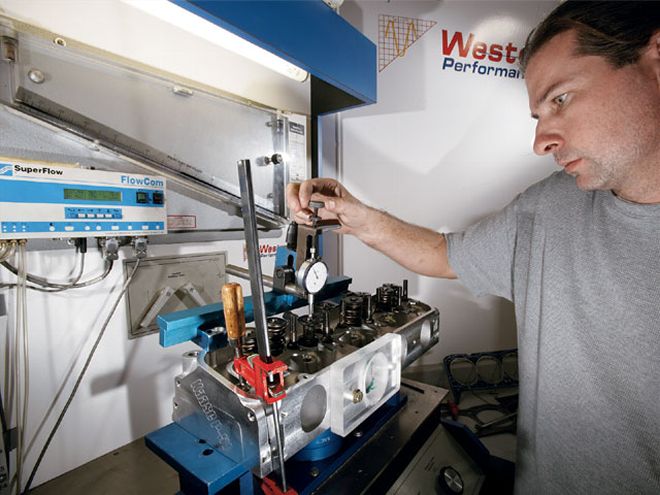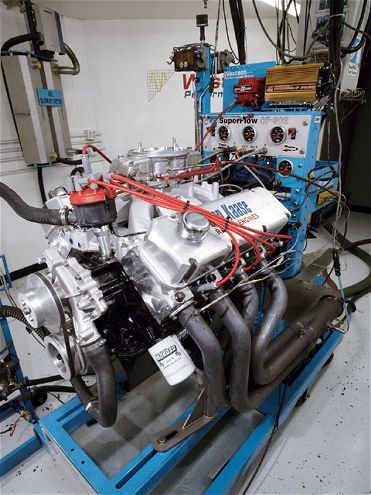
Of the domestic big-block engines, the 429/460 Ford 385-Series came to the party late in the game. Ford depended on the ancient but effective FE-series of engines for big-inch power through most of the '60s musclecar era, introducing the all-new big-block design in 1969. This new fat-block had commendable features, including a wide 4.900-inch bore spacing for man-sized bores, a healthy 10.320-inch deck height, and a spacious crankcase to swallow a burly long-stroke crank. Up top, the engine featured a canted-valve layout and huge ports, borrowing design themes from the famously successful Cleveland small-block series. It seemed like a design with tremendous power potential, and in Cobra Jet and Super Cobra Jet 429 form, the power output was noticeable (with rated outputs of 370 and 375, respectively). Ford's Total Performance attitude didn't stop there, either. Looking for the ultimate weapon in the NASCAR wars, the Boss 429 was created in 1969, and featured a radical canted-valve semi-Hemi cylinder head layout with the intention of fully exploiting the new big-block's power potential.
Ford's reasoning was well directed with the Boss 429. But for all the positive attributes of the Ford's big-block architecture, and given the promise of power offered by the base canted-valve heads and cavernous ports, the ultimate power available from the new design just didn't cut it. Ford's solution was a radical departure in the cylinder head layout-but why? Though the conventional 385-Series heads seemed like a conceptual winner, there were flawed design elements clear in retrospect. Foremost, the valve placement put the centerline of the valve faces too far toward the plug side of the chamber, crowding the outside of the cylinder bore. Combined with the valve angle, this layout did nothing to take advantage of the naturally spacious bores of the bottom end. The problem is readily evident on the intake side, and is especially acute with the exhaust valve, buried deep within the curvature of the bore's outside corner.
From the standpoint of taking advantage of airflow for maximum power, the conventional 429 and 460 cylinder head was a loser, but this shortcoming became inconsequential as the era of maximum factory performance drew to a close. The big-block Ford 429 and its longer-stroke brother, the 460, came to serve primarily as torquey powerplants in huge Ford, Lincoln, and Mercury luxury cars (and as a truck motor). So much promise seemingly squandered.
The Fix Is In
In the '80s, Ford Motorsport (now Ford Racing) took a step forward in the power evolution of the big-block, introducing the aluminum Cobra Jet head. Borrowing its name from the high-performance big-block designation of the '60s, the Cobra Jet head was a conventional 385-Series in layout, but featured better ports and greater airflow when compared to OEM production heads. Although the Cobra Jet heads were an improvement, the fundamental shortcomings of the original design layout had not been addressed. All of that changed with the introduction of the Ford Motorsports Super Cobra Jet heads in 2001.
Under development at Jon Kaase Racing, this new design finally fixed the basic flaws in the original Ford design. Kaase pulled the valves back toward the intake side of the chamber, where they could open in a more geometrically favorable position in relation to the cylinder bore. Along with the dramatic change in valve position, the valve angle was altered slightly on the intake side and drastically on the exhaust side. This new Kaase layout unlocked the power potential of the big-block Ford, and the modified version of the conventional big-block Ford layout was now capable of exceeding the 350-cfm peak intake flow of the exotic Boss 429. It was really a validation of the original canted-valve wedge concept.
The P51
Not content to remain idle, Kaase recently went to work to revise the big-block Ford head once again. This effort builds on the format originally introduced with the Super Cobra Jet head, as it is more evolutionary than revolutionary. Naturally, the Super Cobra Jet head has benefited from six years of development since its introduction, and its as-cast potential was just the beginning, in terms of power and flow. Fully ported, the Super Cobra Jet head was capable of high 300s on the intake flow scale. With the P51, the idea was to incorporate the gains made in port development on the Super Cobra Jet into an all new casting; essentially, the P51 was to be an "as-cast" piece designed to resemble the ports of a fully ported Super Cobra Jet. Material has been added and improvements made to address issues from the previous series of cylinder heads. Along with the revised ports, the P51 takes the combustion chamber to the latest figure-eight shape, filling in a considerable portion of the "dead" area behind the spark plug.
Kaase's new P51 head features a fully CNC-machined chamber, measuring the same 72 cc as the previous generation cylinder head. Other than the redesigned 310cc intake ports, the intake valve diameter has been increased from the earlier head's 2.200 inches to 2.250 inches. The exhaust ports measure 145 cc and carry 1.76-inch diameter valves, and the port throats below the valves come machined and hand-blended (though the remainder of the port comes strictly as-cast). With intake flow of around 400 cfm and an extraordinarily fat flow curve throughout the range (see flow chart), these heads seem to have what it takes to make outrageous power.
Ford Power Test
While flow numbers are certainly informative, there's no better way to judge the potential of big-block Ford power with these new heads than to build an engine and see the results for ourselves. Big-block Ford engines lend themselves to tremendous displacement in stroker combinations, with engines as large as 545 cid easily achieved with stock-block stroker combinations; however, we were interested to see what could be done with just your basic everyday 460. With a factory bore of 4.360 and a stroke of 3.850, the 460 Ford was one of the largest OEM engines in passenger car production. Cores for these engines are readily available and usually found at an incredible bargain, considering the displacement. The plan was to rebuild a basic production-based short-block, stuff it with a few well-chosen power parts, and top it off with these killer new heads from Jon Kaase Racing.
A seasoned stock 460 block was simply prepped with a 0.030-inch overbore and fitted with a set of Probe forged flat-top pistons, using stock Ford connecting rods. Though the rods are OEM forgings, the small ends were bushed for floating pins and new ARP bolts were installed. Inside the roomy crankcase of the 460, the OEM cast-iron crankshaft was retained. As far as the bottom end is concerned, this is just a common street-style rebuild.
Where the build took a walk on the wild side was the camshaft. To gauge the effectiveness on these high-flow cylinder heads, particularly with the relatively modest displacement of the short-block, the engine has to rev. With only 466 cubes at work below, it takes substantial rpm to begin to use up the kind of flow these heads are capable of. In light of this, a solid roller was the only choice, and here was no place to be shy about specifications. A COMP Cams grind No. FF-4420-4132-R108 roller was specified, which rates at 256/262 degrees duration at 0.050-inch tappet rise. When combined with the 1.73 ratio of a Ford big-block's rockers, the cam delivers a whopping 0.761/0.743-inch lift. This would certainly be enough action at the valves to tap into the airflow capabilities of the P51 heads.
Up top went the object of this experiment-the new P51 cylinder heads-which were simply bolted on in out-of-the-box form. As with previous generations of SVO cylinder heads, the P51 retains the production intake port size and bolt pattern, maintaining compatibility with established intake manifolds for this engine type. A box-stock Ford Motorsport single-plane 4500-pattern intake manifold topped with a 1,195-cfm King Demon carburetor provides the induction. What we have here is a generic 460 outfitted to pump a tremendous amount of air. The only question remaining was whether it would result in great horsepower.
That answer became apparent as our test session unfolded on Westech Performance Group's SuperFlow 902 engine dyno. Our objective there was to validate and tune the engine, and then let it eat for the numbers. We weren't intending to apply any parts-swapping, spacers, super-slick oils, or associated super-tuning tricks, but were sticking to the basics of dialing-in the mixture and timing. We began the test session with 100 octane fuel, to provide a safety margin with the decidedly high compression ratio and unknown tune. The first few tuning pulls proved that Ford was intent on delivering uncharacteristic power. Loaded at near peak, static, we found over 600 lb-ft of torque. For a ballpark reference, that's a good 50-plus lb-ft better than what can be considered a "very good" engine at this displacement. Dialed-in at 32 degrees of timing and jetted for a perfect mixture reading, we let it fly and saw a staggering 600 lb-ft of torque and 690 hp at 6,700 rpm.
Testing On Pump Gas
We cleared the fuel system and reloaded with ordinary 91 octane swill. True, the compression ratio was crowding 12:1, but with the generous cam timing, low ignition requirements, aluminum heads, and Kaase's blessing, we figured the engine would cooperate. The testing was repeated with low-grade fuel and there was no hint of detonation. What we did find is abundant power, given the generally humble nature of the engine. On 91 octane, Kaase's P51-equipped 460 showed us 597 lb-ft at 4,900 rpm, running up the powerband to 687 hp at 6,700 rpm. We had a basic short-block that could easily double for the one in a buddy's truck (stock block, crank, rods, and all). Take that basic genetic material, add a hard-hitting COMP roller cam, a Kaase top end, and a matching big induction, and you have a combination that makes way more power than the sum of its parts.
 Cylinder Head Flow Comparison Super Cobra Jet vs. Kaase P51 Valve Lift: Super Cobra Jet: Kaase P51: INTAKE: EXHAUST: INTAKE: EXHAUST: .{{{100}}} 70 52 72 52 .{{{200}}} 154 103 152 107 .{{{300}}} 202 139 234 151 .400 248 185 306 183 .500 274 200 350 202 .{{{600}}} 298 208 368 215 .700 309 212 388 229 .800 318 214 395 239
P51 Cylinder Head Specs Intake runner volume: 310 cc Exhaust port volume: 145 cc Intake valve diameter: 2.250 inches Exhaust valve diameter: 1.{{{760}}} inches Valve length (int./exh.): 5.245/5.080 Intake valve angle: 8.3 degrees Intake valve cant: 4.7 degrees Exhaust valve angle: 4.0 degrees Exhaust valve cant: 3.2 degrees Spring diameter: 1.550 inches Valve guide: 11/32 inch Cost (pair, bare): $1,590.00
Cylinder Head Flow Comparison Super Cobra Jet vs. Kaase P51 Valve Lift: Super Cobra Jet: Kaase P51: INTAKE: EXHAUST: INTAKE: EXHAUST: .{{{100}}} 70 52 72 52 .{{{200}}} 154 103 152 107 .{{{300}}} 202 139 234 151 .400 248 185 306 183 .500 274 200 350 202 .{{{600}}} 298 208 368 215 .700 309 212 388 229 .800 318 214 395 239
P51 Cylinder Head Specs Intake runner volume: 310 cc Exhaust port volume: 145 cc Intake valve diameter: 2.250 inches Exhaust valve diameter: 1.{{{760}}} inches Valve length (int./exh.): 5.245/5.080 Intake valve angle: 8.3 degrees Intake valve cant: 4.7 degrees Exhaust valve angle: 4.0 degrees Exhaust valve cant: 3.2 degrees Spring diameter: 1.550 inches Valve guide: 11/32 inch Cost (pair, bare): $1,590.00

DTS Dyno Results
Jon Kaase 466 Cid 385-Series Ford
Superflow 902 Engine Dyno STP Correction Factor
RPM TQ HP RPM TQ HP 3,000 462 264 5,200 593 587 3,200 458 279 5,400 587 603 3,400 457 269 5,600 582 620 3,600 469 321 5,800 576 636 3,800 489 354 6,000 570 651 4,000 518 394 6,200 564 666 4,200 548 438 6,400 557 679 4,400 573 480 6,600 547 687 4,600 589 516 6,800 531 687 4,800 597 545 7,000 509 678 5,000 596 568
Kaase 460 Parts List
While this story is ostensibly about Kaase's P51 head, we also realize these pieces don't exist in a vacuum-you still need an engine to bolt them to. What follows is a blow-by-blow, bolt-by-bolt list of the components in our test engine, which was assembled for us by Jon Kaase Racing. To build a replica, you'd need these items, or their equivalent. A quick inspection of the list reveals our 460 test motor to be fairly typical of a hot street piece. Some judicious trimming could cut the cost without any negative effect, or you could beef things up for more serious race duty. The main thing is that there are no exotic parts and no special porting. Best of all, these pieces are readily available as off-the-shelf items. We've also referenced the Jegs catalog for typical mail-order pricing.